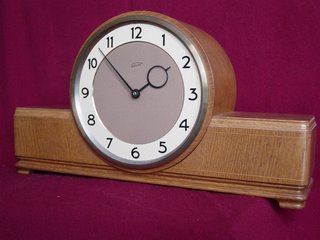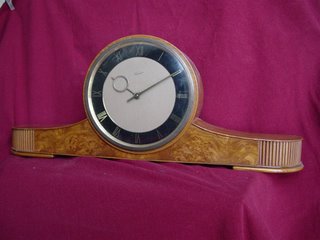Wide? At one point Telavox produced some very wide mantle clock cases indeed but this is a more modest example. This is the only white chapter ring I have seen so far. I think it gives the clock a rather crisp and modern appearance compared with the majority of more subdued Telavox dials. The dial appears clearer here than some of my other photos simply because the glass was removed before I obtained this clock. Probably because it was broken. A new dial glass could be obtained through clock repairers suppliers.
It is very difficult to photograph clocks with domed glass over the dials. My trick is to photograph in a light place with a large black cloth behind the camera. Even so a slanted viewpoint seems essential to avoid annoying reflections of the camera on its tripod. I learnt years ago not to stand behind the camera to avoid seeing myself reflected in the glass on my photographs. Flash is best avoided and most of my dial images are taken with available light.

Wider? I call this style wide, stepped, square toe. The plain dials seem to indicate early clocks. This clock has a low serial number and strikes on a bell. The battery compartment underneath has been rubber stamped with a date of 1944. I have now obtained a dark wood case with plain brass dial date stamped 1945. Unfortunately it is a quartz conversion. Sadly very few Telavoxes are visibly date stamped.
Or widest? This is the very wide, round toe in the database. Here is an example of a very wide Telavox with a black chapter ring. The reflective brass numerals are causing problems for the camera.
Despite the wide case the bold Telavox dial and its generous size gives the clock a nicely balanced appearance. The very ends of the case are vertically ribbed with matching hardwood. The curly grained veneer on this clock case is superb.
Click on any image for a larger version. Back click to return to the blog.
*


No comments:
Post a Comment